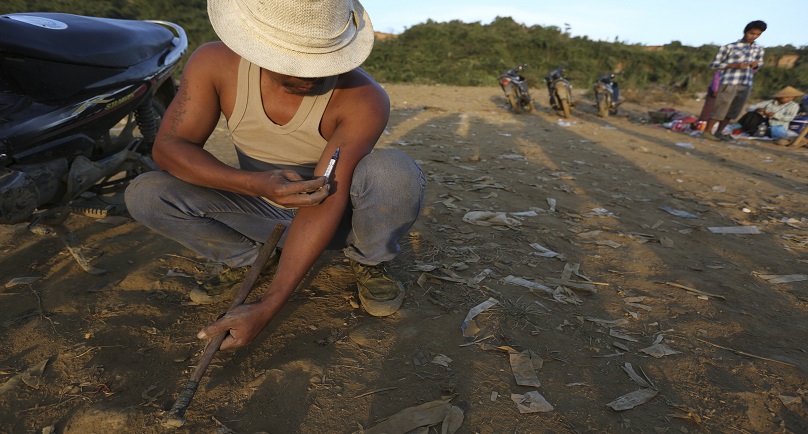Image: A miner injects heroin at a mine dump at a Hpakant jade mine in Kachin state, Myanmar November 29, 2015. REUTERS/Soe Zeya Tun
By Aye Win Myint
YANGON (Reuters) – Unsuccessful jade scavengers in Myanmar seeking to assuage their despair are swelling a tide of drug abuse in Kachin state that presents a challenge for the untested government of Nobel laureate Aung San Suu Kyi after its landslide election win.
Narcotics addiction is rife among the gem scavengers or “handpickers” who flock to the northern township of Hpakant, producer of some of the world’s highest quality jade, in hopes of finding lumps of the precious stone overlooked by big miners.
But the gems elude many of them. Some start using heroin to help survive the harsh working conditions, often openly injecting themselves, and others even contract HIV, the virus that causes AIDS.
“I do want to quit drugs at the moment,” said 25-year old Phyo Nyi, who was introduced to drug use by a friend five years ago. “If I can quit this, I am going to find gemstones. That’s what I want to do.”
Activists worry about the growing number of serious drug users, especially the young, and say the Myanmar authorities lack the will to tackle the issue.
“The authorities are saying there are no more drugs in Kachin state,” said Naung Latt, a member of the region’s Anti-Drug Action Group.
“But all young persons are drug victims now. Most of the state school students above grade six are using drugs and some are injecting themselves.”
A presidential spokesman did not immediately respond to requests for comment on the issue.
Resolving the issue will be a thorny task for the government led by Suu Kyi, whose party election manifesto made only two fleeting references to narcotics..
Even under an NLD government, the military will retain formal control over the ministries of defense, border affairs and home affairs – all crucial to counter-narcotics efforts.
Most drugs are produced in border areas controlled by ethnic rebel armies or by the Myanmar military and allied militias.
The boom in Hpakant’s population coincided with an exponential rise in opium production in Myanmar, the world’s second-largest producer after Afghanistan.
Heroin, an opium derivative, is cheap and widely available in Kachin State, and Hpakant’s workforce seems to run on it.
Myanmar produced an estimated 647 tons of opium in 2015, second only to Afghanistan, the United Nations Office on Drugs and Crime (UNODC) said on Tuesday.
That figure was steady from the previous year, as was the total area under opium poppy cultivation, which stood at 55,500 hectares (212 sq miles) in 2015, the UNODC said.
Aid workers say their effort to rein in disease includes hiring drug users to earn a few dollars by collecting used syringes in a disposable box.
“Before, I thought only people of Kachin and Shan ethnicity were using drugs,” said activist Naung Latt. “But there are now many people who come from different parts of the country, using drugs and losing their lives.”
(Writing by Andrew Marshall; Editing by Clarence Fernandez)
Copyright 2015 Thomson Reuters. Click for Restrictions.


